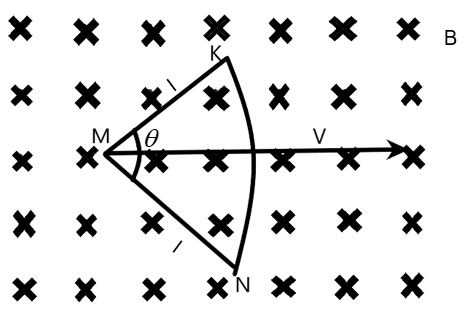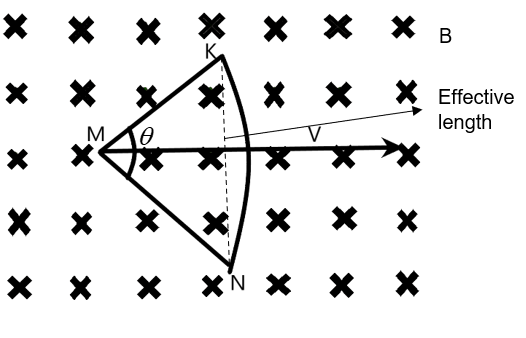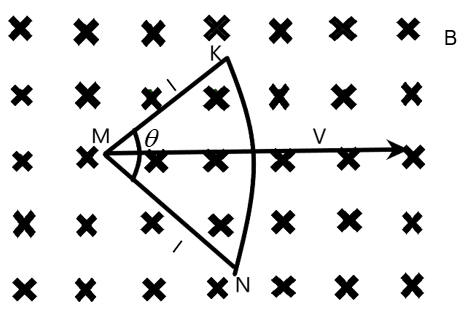Answer
412.5k+ views
Hint: We are given the direction of motion of a conducting wire in a magnetic field with its velocity in the field. We need to find the related changes that occur in this wire due to this motion in the given magnetic field such as the emf and the effective length.
Complete answer:
We know that any conductor moving in a magnetic field which has a perpendicular component of motion to the field can develop a motional emf along its two ends. A conductor moving with a constant velocity and in a constant angle will not produce a change in flux, so there will be no emf produced.
In our case a wire KMN is moving with a constant velocity with an angle, therefore, a motional emf is generated along its motion.
We know that the motional emf of a conductor is given as –
\[\varepsilon =Blv\]
Where, l is the effective length of the wire used.

From the below figure, we can understand that the effective length of the wire is along \[\sin \dfrac{\theta }{2}\], so the length will be \[2l\sin \dfrac{\theta }{2}\], given that KM and MN is of length ‘l’.

Now, let us calculate the motional emf of the wire KMN as –
\[\begin{align}
& \varepsilon =l(v\times B) \\
& \text{Here,} \\
& l=2l \\
& \Rightarrow \varepsilon =2Blv\sin \dfrac{\theta }{2} \\
\end{align}\]
Also, we find from our observations that the KMN is immaterial, what matters is just the two end endpoints K and N.
So, we have found that all the options in the question are true.
The correct answer is option D.
Note:
We will find from the above exercise that the shape of the wire doesn’t account for the motional emf induced in it. It is the effective length which determines the amount of emf induced due to the movement of the conductor through the magnetic field.
Complete answer:
We know that any conductor moving in a magnetic field which has a perpendicular component of motion to the field can develop a motional emf along its two ends. A conductor moving with a constant velocity and in a constant angle will not produce a change in flux, so there will be no emf produced.
In our case a wire KMN is moving with a constant velocity with an angle, therefore, a motional emf is generated along its motion.
We know that the motional emf of a conductor is given as –
\[\varepsilon =Blv\]
Where, l is the effective length of the wire used.

From the below figure, we can understand that the effective length of the wire is along \[\sin \dfrac{\theta }{2}\], so the length will be \[2l\sin \dfrac{\theta }{2}\], given that KM and MN is of length ‘l’.

Now, let us calculate the motional emf of the wire KMN as –
\[\begin{align}
& \varepsilon =l(v\times B) \\
& \text{Here,} \\
& l=2l \\
& \Rightarrow \varepsilon =2Blv\sin \dfrac{\theta }{2} \\
\end{align}\]
Also, we find from our observations that the KMN is immaterial, what matters is just the two end endpoints K and N.
So, we have found that all the options in the question are true.
The correct answer is option D.
Note:
We will find from the above exercise that the shape of the wire doesn’t account for the motional emf induced in it. It is the effective length which determines the amount of emf induced due to the movement of the conductor through the magnetic field.
Recently Updated Pages
Mark and label the given geoinformation on the outline class 11 social science CBSE

When people say No pun intended what does that mea class 8 english CBSE

Name the states which share their boundary with Indias class 9 social science CBSE

Give an account of the Northern Plains of India class 9 social science CBSE

Change the following sentences into negative and interrogative class 10 english CBSE

Advantages and disadvantages of science

Trending doubts
Which are the Top 10 Largest Countries of the World?

Difference between Prokaryotic cell and Eukaryotic class 11 biology CBSE

Differentiate between homogeneous and heterogeneous class 12 chemistry CBSE

10 examples of evaporation in daily life with explanations

Fill the blanks with the suitable prepositions 1 The class 9 english CBSE

How do you graph the function fx 4x class 9 maths CBSE

The Equation xxx + 2 is Satisfied when x is Equal to Class 10 Maths

Difference Between Plant Cell and Animal Cell

What are the monomers and polymers of carbohydrate class 12 chemistry CBSE




